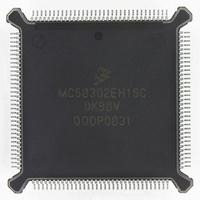MC68302EH16C Freescale Semiconductor, MC68302EH16C Datasheet - Page 67

MC68302EH16C
Manufacturer Part Number
MC68302EH16C
Description
IC MPU MULTI-PROTOCOL 132-PQFP
Manufacturer
Freescale Semiconductor
Datasheets
1.MC68302AG20C.pdf
(4 pages)
2.MC68302AG20C.pdf
(2 pages)
3.MC68302AG20C.pdf
(13 pages)
4.MC68302EH16C.pdf
(481 pages)
Specifications of MC68302EH16C
Processor Type
M683xx 32-Bit
Speed
16MHz
Voltage
5V
Mounting Type
Surface Mount
Package / Case
132-MQFP, 132-PQFP
Controller Family/series
68K
Core Size
32 Bit
Ram Memory Size
1152Byte
Cpu Speed
16MHz
No. Of Timers
3
Embedded Interface Type
SCP, TDM
Digital Ic Case Style
PQFP
Rohs Compliant
Yes
Family Name
M68000
Device Core
ColdFire
Device Core Size
32b
Frequency (max)
16MHz
Instruction Set Architecture
RISC
Supply Voltage 1 (typ)
5V
Operating Temp Range
0C to 70C
Operating Temperature Classification
Commercial
Mounting
Surface Mount
Pin Count
132
Package Type
PQFP
Lead Free Status / RoHS Status
Lead free / RoHS Compliant
Features
-
Lead Free Status / Rohs Status
RoHS Compliant part
Electrostatic Device
Available stocks
Company
Part Number
Manufacturer
Quantity
Price
Company:
Part Number:
MC68302EH16C
Manufacturer:
Freescale Semiconductor
Quantity:
135
Company:
Part Number:
MC68302EH16C
Manufacturer:
PANA
Quantity:
99
Company:
Part Number:
MC68302EH16C
Manufacturer:
Freescale Semiconductor
Quantity:
10 000
Part Number:
MC68302EH16C
Manufacturer:
FREESCALE
Quantity:
20 000
Company:
Part Number:
MC68302EH16CB1
Manufacturer:
Freescale Semiconductor
Quantity:
10 000
Company:
Part Number:
MC68302EH16CR2
Manufacturer:
Freescale Semiconductor
Quantity:
10 000
- MC68302AG20C PDF datasheet
- MC68302AG20C PDF datasheet #2
- MC68302AG20C PDF datasheet #3
- MC68302EH16C PDF datasheet #4
- Current page: 67 of 481
- Download datasheet (2Mb)
Steps 2 and 4 are the responsibility of the M68000 core on the IMP; whereas, steps 1 and
3 are the responsibility of the interrupt controller on the IMP.
The M68000 core is not modified on the IMP; thus, steps 2 and 4 operate exactly as they
would on the MC68000. In step 2, the M68000 status register (SR) is available to mask in-
terrupts globally or to determine which priority levels can currently generate interrupts (see
2.5 Interrupt Processing for more details). Also in step 2, the interrupt acknowledge cycle is
executed.
The interrupt acknowledge cycle carries out a standard M68000 bus read cycle, except that
FC2–FC0 are encoded as 111, A3–A1 are encoded with the interrupt priority level (1–7, with
7 (i.e., 111) being the highest), and A19–A16 are driven high. UDS and LDS are both driven
low.
In step 4, the M68000 reads the vector number, multiplies it by 4 to get the vector address,
fetches a 4-byte program address from that vector address (seeTable 2-5), and then jumps
to that 4-byte address. That 4-byte address is the location of the first instruction in the inter-
rupt handler.
Steps 1 and 3 are the responsibility of the interrupt controller on the IMP. In steps 1 and 3,
a number of configuration options are available. For instance, in step 1, there are two modes
for handling external interrupts: normal and dedicated. In step 3, there are several different
ways of generating vectors. These and other interrupt controller options are introduced in
the following paragraphs.
3.2.1.2 Interrupt Controller Overview
The interrupt controller receives interrupts from internal sources such as the timers, the
IDMA controller, the serial communication controllers, and the parallel I/O pins (port B pins
11–8). These interrupts are called internal requests (INRQ). The interrupt controller allows
for masking each INRQ interrupt source. When multiple events within a peripheral can
cause the INRQ interrupt, each event is also maskable in a register in that peripheral.
In addition to the INRQ interrupts, the interrupt controller can also receive external requests
(EXRQ). EXRQ interrupts are input to the IMP according to normal or dedicated mode. In
the normal mode, EXRQ interrupts are encoded on the IPL2–IPL0 lines. In the dedicated
mode, EXRQ interrupts are presented directly as IRQ7, IRQ6, and IRQ1.
Normal Mode
MOTOROLA
3. The interrupt controller recognizes the interrupt acknowledge cycle and places the in-
4. The M68000 reads the vector, reads the address of the interrupt handler in the excep-
In this mode, the three external interrupt request pins are configured as IPL2–IPL0 as in
the original MC68000. Up to seven levels of interrupt priority may be encoded. Level 4 is
reserved for IMP INRQ interrupts and may not be generated by an external device.
bus cycle after the completion of the current instruction.
terrupt vector for that interrupt request onto the M68000 bus.
tion vector table, and then begins execution at that address.
MC68302 USER’S MANUAL
System Integration Block (SIB)
3-17
Related parts for MC68302EH16C
Image
Part Number
Description
Manufacturer
Datasheet
Request
R
Part Number:
Description:
Manufacturer:
Freescale Semiconductor, Inc
Datasheet:

Part Number:
Description:
MC68302 Configuring the Chip Selects on the MC68302
Manufacturer:
Motorola / Freescale Semiconductor

Part Number:
Description:
MC68302 Design Concept - Expanding Interrupts on the MC68302
Manufacturer:
Motorola / Freescale Semiconductor

Part Number:
Description:
MC68302 MC68302 Adapting a WAN Controller to a LAN Environment
Manufacturer:
Motorola / Freescale Semiconductor

Part Number:
Description:
MC68302 EKB Applications - Power Measurements on the MC68302
Manufacturer:
Motorola / Freescale Semiconductor

Part Number:
Description:
MC68302 Interfacing the MC68020 to a Slave MC68302
Manufacturer:
Motorola / Freescale Semiconductor

Part Number:
Description:
MC68302 MC68302 Software Performance
Manufacturer:
Motorola / Freescale Semiconductor

Part Number:
Description:
MC68302 Evaluating EDX on the ADS302
Manufacturer:
Motorola / Freescale Semiconductor

Part Number:
Description:
MC68302 Design Advisory #1 - MC68SC302 Passive ISDN Protocol Engine
Manufacturer:
Motorola / Freescale Semiconductor

Part Number:
Description:
MC68302, MC68360, and MPC860 Characteristics and Design Notes for Crystal Feedback Oscillators
Manufacturer:
Motorola / Freescale Semiconductor
Part Number:
Description:
Mc68302 Integrated Multi-protocol Processor
Manufacturer:
Freescale Semiconductor, Inc
Datasheet:
Part Number:
Description:
Manufacturer:
Freescale Semiconductor, Inc
Datasheet:
Part Number:
Description:
Manufacturer:
Freescale Semiconductor, Inc
Datasheet:
Part Number:
Description:
Manufacturer:
Freescale Semiconductor, Inc
Datasheet:
Part Number:
Description:
Manufacturer:
Freescale Semiconductor, Inc
Datasheet:











